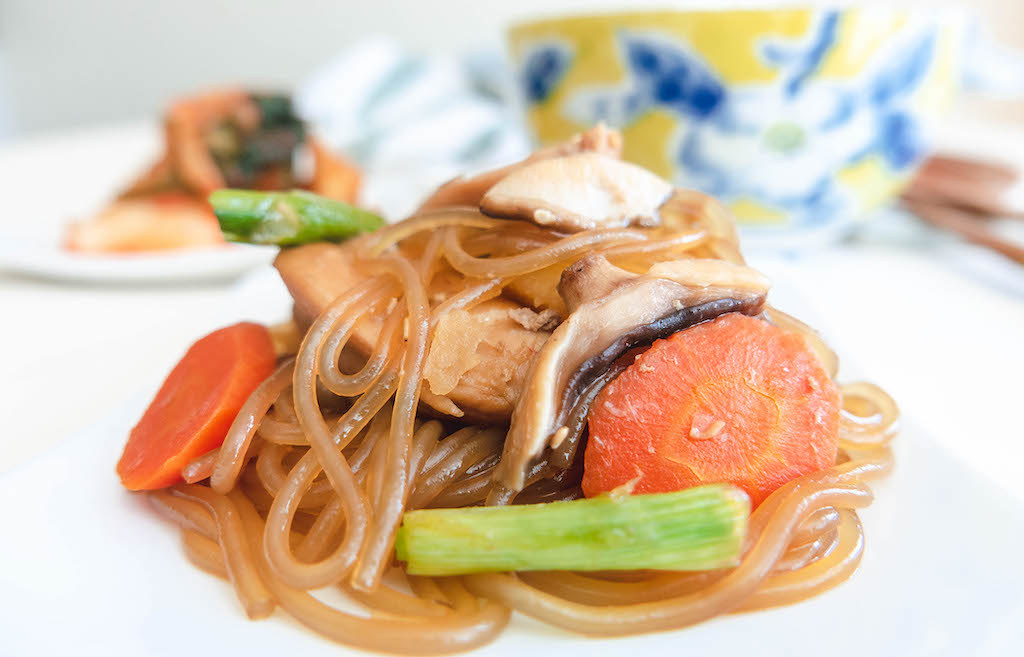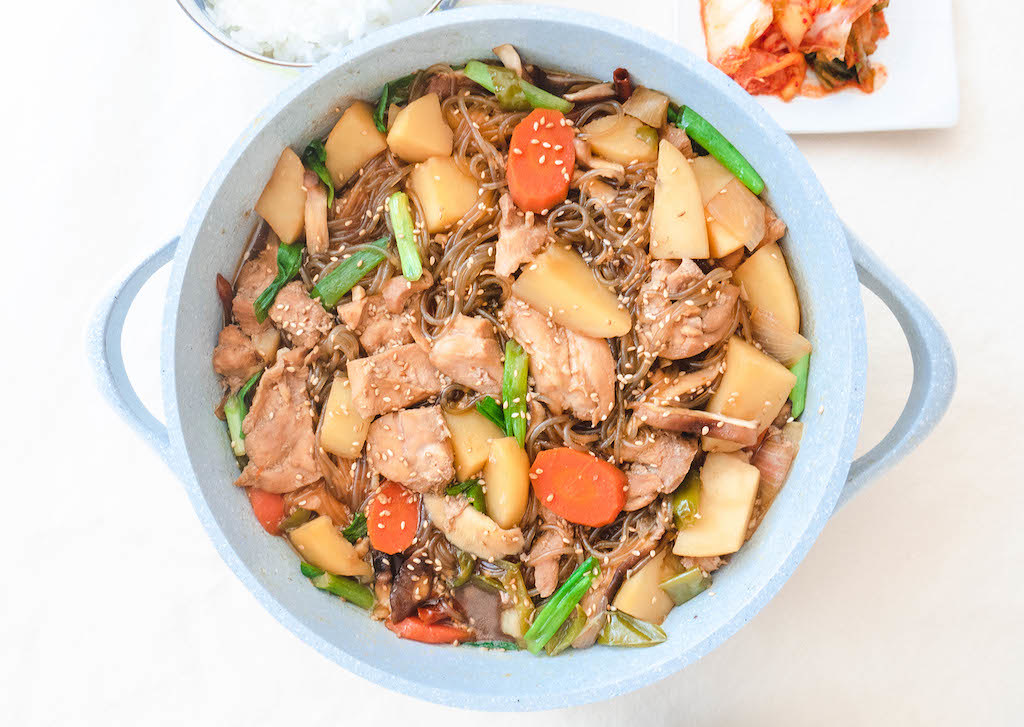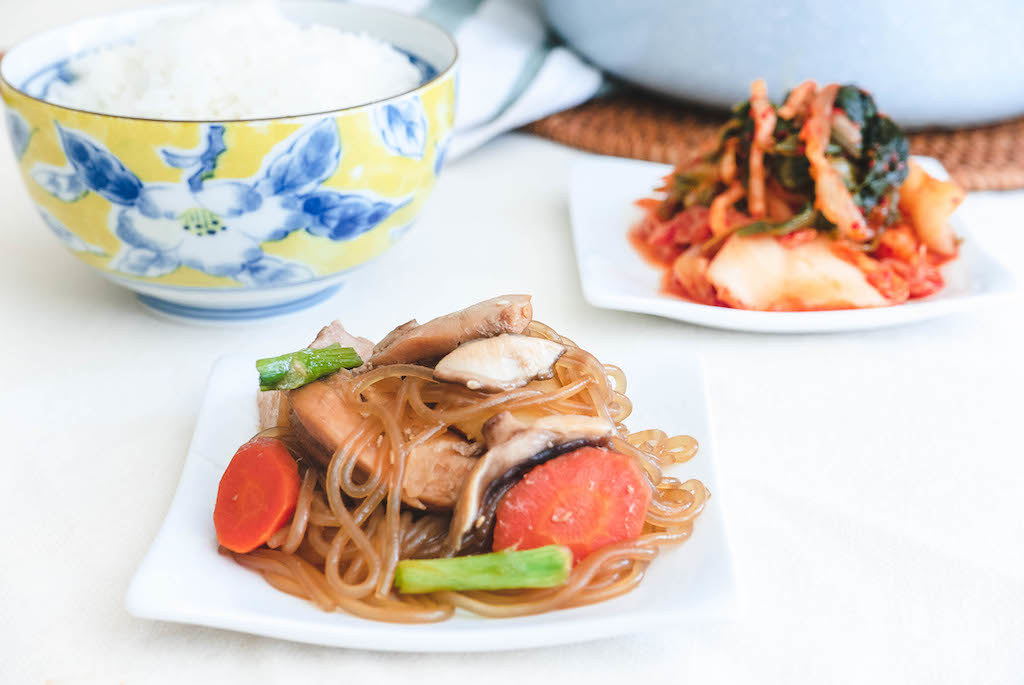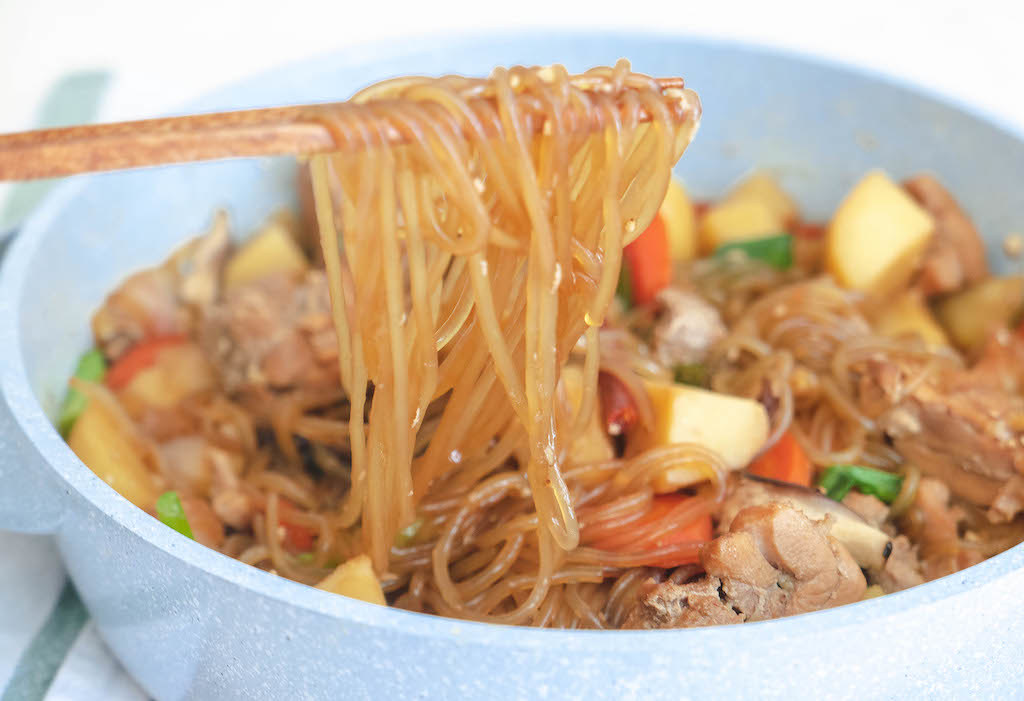This post may contain affiliate links. Please read my disclosure for details at the bottom of this page. As an Amazon Associate, I earn from qualifying purchases on this spicy Andong jjimdak recipe. We hope you enjoy learning how to make Korean braised chicken!
I love recipes that include everything you need in one dish–you have your starch, your protein, and veggies all in one pot. Having everything in one pot makes dinner easy and convenient! Of this style of dish, one of my favorite Korean recipes is for Andong jjimdak!
Andong jjimdak is a Korean braised chicken dish. This slightly sweet and savory dish is packed full of healthy chicken protein, different vegetables (such as potatoes, carrots, and mushrooms), and long sweet potato noodles. Soon, your heart and stomach will be full from this Korean Andong jjimdak recipe!
Before we get to the recipe, let’s learn about this dish!
What is Jjim?
In South Korea, the term jjim (찜) refers to different styles of dishes made by steaming or boiling marinated meat in a liquid–such as broth, sauce, or soup.
In the past, jjim specifically referred to dishes cooked in an earthenware pot called siru (시루). Famously, this earthenware steamer is still often used to cook tteok, otherwise known as Korean rice cakes. This sirutteok is regarded as the oldest style of rice cake known in Korean history.

However, nowadays, jjim can refer to any dish with a steamed appearance. Typically, people make jjim dishes by boiling the ingredients in a soup or sauce until the liquid reduces. Often, to fully cook the meat and reduce the liquid, they use a large pot or pressure cooker.
Below, we listed different types of jjim you can try making at home, eating in a Korean restaurant, or trying when you visit South Korea.
Examples of Jjim:
- Galbijjim: To make galbijjim, you first marinade beef short ribs in a ganjang (Korean soy sauce) based sauce with diced potatoes and carrots. Once marinated, the short ribs are then steamed in a pot.
- Gyeranjjim: Steamed eggs typically made in an earthenware pot.
- Saengseon jjim: A style of dish made using different types of steamed or boiled seafood.
- Dubujjim: A type of jjim made using tofu.
Finally, the last example of jjim we will share is Andong jjimdak. Below, let’s learn all about this dish before we get to the recipe!

What is Andong Jjimdak?
Andong-jjimdak refers to a variety of jjim made using chicken! This dish originated in the city of Andong, Gyeongsangbuk-do Province in South Korea. In the Korean language, Andong jjimdak means ‘steamed Andong chicken.’ Andong refers to the location, jjim refers to the style of steamed dish, and dak refers to the actual chicken.
Traditionally, people from Andong made this dish with chicken and various types of vegetables such as green onion, carrots, potatoes, and spicy chili peppers. Then, all of the ingredients are marinated and cooked in a ganjang (Korean soy sauce) based sauce.
What Does Andong Jjimdak Taste Like?
When cooking Andong chicken, you braise the chicken and other ingredients in a slightly sweet and savory sauce made using Korean-style soy sauce. The sauce takes on the flavors of the different vegetables boiled in the liquid. Most notably, the dish typically has a spicy kick from dried hot chili peppers.
Note: Unlike many other dishes such as Dakbokkeumtang (Korean spicy chicken), Andong jjimdak does not use gochujang (Korean fermented chili paste) or gochugaru (Korean chili flakes). Instead, the spice comes from whole dried peppers and fresh sliced peppers added to the dish. Depending on your spice tolerance, you can add or take away the hot peppers from the dish!

Andong Jjimdak Frequently Asked Questions:
Below, we listed some questions you may have about this dish. If we didn’t answer your questions, please feel free to leave your questions in the comment section or email us at [email protected].
What Type of Chicken Should I Use?
Traditionally, Koreans serve whole chicken cut into pieces in Andong Jjimdak (Korean braised chicken). As a result, you will need to eat around the bones in the dish.
While traditional, I know the bones could cause issues for those not used to eating meat with chopsticks, or for people who always buy boneless meat at the grocery store. As such, I decided to make this recipe using boneless chicken thighs, but will include instructions for those who want the bone-in, truly authentic Andong chicken taste!

What Type of Pot Should I Use?
In South Korea, people use a wide and shallow pot to make jjimdak. The reason for this is that the food cooks more quickly and evenly. If you use a pot with tall sides, it takes much longer for the liquid to reduce. The longer you need to cook the dish for the liquid to reduce, the tougher the meat will get!
Why Should I Soak the Potatoes and Noodles?
Before cooking white short-grained rice, my husband taught me that people in Korea wash it in cold water at least 2-3 times. Besides washing off potential pesticides or chemicals, it removes some of the starch from the rice. This way, the rice isn’t as gooey, mushy, and sticky once cooked.
When you soak the potatoes and noodles for our Andong jjimdak recipe, you are also removing some of the starch from the two ingredients. The more starch in the dish, the thicker and stickier the jjimdak gets. For this dish, you want a nice balance between the reduced liquid and ingredients.
Also, soaking the noodles cuts the cooking time down as it allows the noodles to soften before adding to the pot! We don’t want to cook the chicken to the point of being tough!

Can I Make This Gluten-Free?
Yes! Andong jjimdak can easily be made gluten-free. Korean sweet potato noodles are naturally gluten-free. So, you do not need to worry about that!
The only two ingredients that often contain gluten are the soy sauce and the oyster sauce. Thankfully, there are many gluten-free options for these ingredients available on the market. Try finding ingredients such as gluten-free tamari soy sauce and oyster sauce in grocery stores and online!
For those curious about soy sauce and tamari, you can check out our blog post explaining the difference between the two!
What Should I Serve With Andong Jjimdak?
Andong jjimdak contains everything you need for a hearty and filling meal. It contains vegetables, protein, and starch from the sweet potato noodles. So, if you want to eat it on its own, you can easily feel full and satisfied.
Though that is the case, I recommend serving this dish with a bowl of hot, steaming white rice and a side of kimchi. You can pick out some other styles of banchan (Korean side dish) such as maneul jangajji (Korean pickled garlic) to complete your meal.
If you are in the mood to drink, I recommend serving this dish with traditional Korean soju. Actually, Andong is also famous for their truly traditional style of soju. If you are not good at taking shots, try our soju and tonic or soju caipirinha cocktail recipes!

How to Store Leftovers
If you have any leftovers, place them in an airtight container in the refrigerator. You can keep the leftovers for a few days in the fridge.
To Reheat Andong Jjimdak:
Microwave: Using a microwave-safe container, heat your Andong jjimdak 1 minute at a time until fully heated. Stir after each minute.
Stovetop: Turn to medium-high heat and let the jjimdak cook until it is steaming and hot. If the liquid is too reduced, add a little water to the pot and mix everything together.

Do You Like Andong Jjimdak?
In the end, did you enjoy eating our Andong jjimdak recipe? If so, let us know in the comment section below! Also, if you have any questions, you can leave them in the comment section!
If you would like to try more Korean food, check out the recipes below!
Korean Food and Drink Recipes:
- Mayak Eggs (Korean Marinated Eggs)
- Maneul Jangajji (Korean Pickled Garlic)
- Romaine Sangchu Geotjeori (Korean Romaine Lettuce Salad)
- Soju and Tonic (A Korean Soju Cocktail)
- Soju Caipirinha (A Korean Take on Brazil’s National Drink); and
- Cheese Kimbap
If you have any questions or comments, you can also email us at [email protected].
Finally, we would love to hear from you through our social media as well! You can follow us at @carvingajourney on Instagram, Twitter, Facebook, and Pinterest. Or, if you would like more articles like these, you can subscribe to our blog by joining our mailing list. We hope you enjoyed our Andong jjimdak recipe! Thank you so much for stopping by!
Carving A Journey is a participant in the Amazon Services LLC Associates Program, an affiliate advertising program designed to provide a means for sites to earn advertising fees by advertising and linking to Amazon.com. Although we may earn commissions for our endorsement, recommendation, testimonial, and/or link to any products or services from this website, these opinions are my own and I fully support these products.


